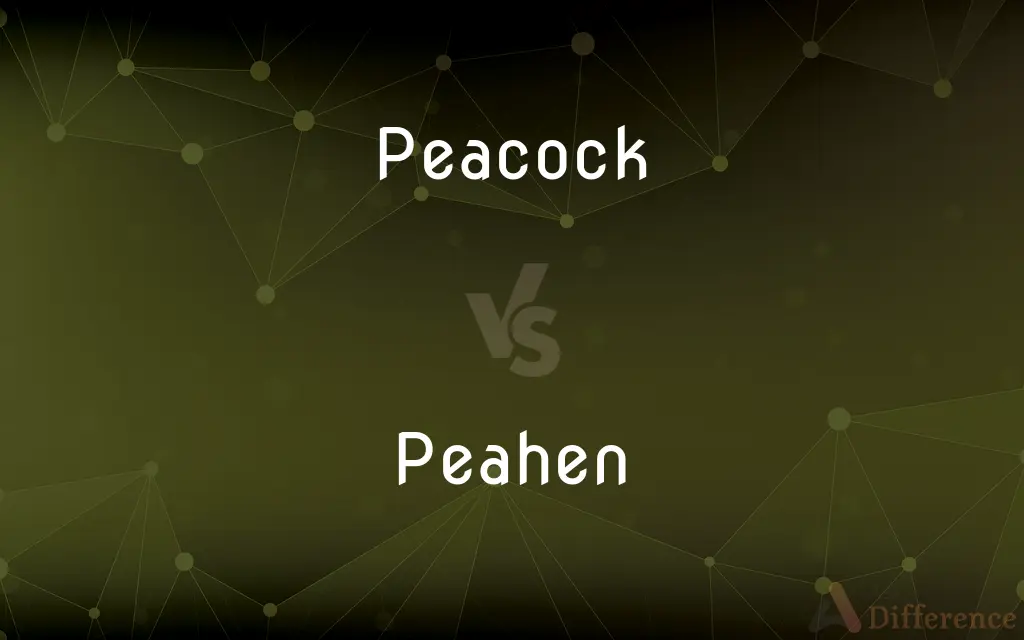Peacock vs. Peahen — What's the Difference?
By Fiza Rafique & Urooj Arif — Updated on April 14, 2024
Peacocks are male birds known for their colorful and extravagant tail feathers, used in mating displays; peahens, the females, are less vibrant and lack the elaborate tail.

Difference Between Peacock and Peahen
Table of Contents
ADVERTISEMENT
Key Differences
Peacocks are renowned for their iridescent, eye-spotted tail feathers, which they fan out to attract peahens during mating rituals. Whereas peahens possess a more muted brown and green plumage that serves as camouflage in their natural habitat.
In terms of behavior, peacocks are more conspicuous and perform elaborate displays to showcase their plumage. On the other hand, peahens are typically more reserved and less visible in the wild.
The vocalizations of peacocks include loud calls that can be heard from a great distance, designed to attract females and deter rivals. Conversely, peahens are much quieter, generally only vocalizing softly when they are alarmed or communicating with their chicks.
Reproductive roles also differentiate these birds: peacocks do not participate in nurturing the young, focusing on attracting multiple mates. Peahens, however, invest heavily in parenting, from incubating eggs to teaching the chicks survival skills.
Peacocks may interact with multiple peahens during the mating season to increase their chances of reproduction. Peahens, however, are often seen in groups with other females and juveniles, forming tighter social units.
ADVERTISEMENT
Comparison Chart
Plumage Color
Vibrant, multicolored
Muted, primarily brown/green
Tail Feathers
Long, ornate, eye-spotted
Short, lacks ornamentation
Behavior
Displays prominently
More reserved
Vocalization
Loud, far-reaching calls
Quieter, subtle calls
Reproductive Role
Solely attracts mates
Incubates eggs, rears chicks
Compare with Definitions
Peacock
Can refer to any ostentatiously showy or vain person.
He strutted around the party like a peacock, drawing everyone's eyes.
Peahen
A female bird of the species Pavo cristatus, less colorful than the male.
The peahen blended into the underbrush with her muted feathers.
Peacock
Exhibits behavior intended to attract mates through visual and auditory signals.
During mating season, a peacock's call can be heard throughout the forest.
Peahen
Generally quieter and less visible than the male.
The peahen remained silent, alert for any sign of predators.
Peacock
Does not participate in nurturing offspring.
After mating, the peacock plays no role in the care of the chicks.
Peahen
Often forms social groups with other females and young.
A group of peahens and their chicks foraged together in the field.
Peacock
Belongs to the peafowl family, which includes several species.
The peacock is one of the most recognizable members of the peafowl family.
Peahen
Also belongs to the peafowl family, essential for species continuation.
Peahens play a crucial role in the continuation of their species.
Peacock
A male bird of the species Pavo cristatus, known for its colorful plumage.
The peacock fanned his spectacular tail feathers in a dazzling display.
Peahen
Focuses on egg incubation and chick rearing.
The peahen diligently warmed her eggs in the nest.
Peacock
A male peafowl, which has very long tail feathers that have eye-like markings and can be erected and fanned out in display.
Peahen
A female peafowl.
Peacock
A male peafowl, distinguished by its crested head, brilliant blue or green plumage, and long modified back feathers that are marked with iridescent eyelike spots and that can be spread in a fanlike form.
Peahen
A female peafowl.
Peacock
A peafowl, either male or female.
Peahen
The hen or female peafowl.
Peacock
A vain or ostentatious person.
Peahen
Female peafowl
Peacock
To strut about like a peacock; exhibit oneself vainly.
Peacock
A male peafowl, especially Pavo cristatus, notable for its brilliant iridescently ocellated tail.
Peacock
A peafowl (of the genus Pavo or Afropavo), either male or female.
Peacock
A vainglorious person from the 14th c..
Peacock
(entomology) Any of various Asian species of papilionid butterflies of the genus Papilio.
Peacock
(intransitive) To strut about proudly or haughtily.
Peacock
(intransitive) To engage in peacocking, ostentatious dress or behaviour to impress women.
Peacock
The male of any pheasant of the genus Pavo, of which at least two species are known, native of Southern Asia and the East Indies.
Peacock
In common usage, the species in general or collectively; a peafowl.
Peacock
European butterfly having reddish-brown wings each marked with a purple eyespot
Peacock
Male peafowl; having a crested head and very large fanlike tail marked with iridescent eyes or spots
Common Curiosities
Do peahens participate in mating displays?
No, peahens do not participate in mating displays; they are the observers, selecting mates based on the display quality.
Can peacocks fly despite their large tail feathers?
Yes, peacocks can fly, but typically only for short distances due to their heavy and elaborate tail feathers.
What sounds do peahens make?
Peahens make a soft cooing sound, which is much less loud compared to the calls of peacocks.
What are the main physical differences between a peacock and a peahen?
The main difference is in their plumage; peacocks have colorful, long tail feathers, whereas peahens have shorter, more subdued feathers.
Why do peacocks have such bright feathers?
Bright feathers in peacocks are used to attract mates and intimidate rivals.
What do peahens eat?
Peahens eat a variety of foods, including insects, plants, and small creatures.
How do peacocks attract peahens?
Peacocks attract peahens by fanning their tail feathers and performing specific dances and vocalizations.
What is the role of a peahen during the breeding season?
During the breeding season, a peahen's role is to select a mate, lay eggs, and care for the chicks.
Are peahens involved in choosing their mates?
Yes, peahens are very selective and play a critical role in choosing their mates based on the males' display qualities.
Are peahens as colorful as peacocks?
No, peahens are not as colorful; they have mostly brown and green plumage which helps them blend into their environment.
How long do peacocks and peahens live?
Peacocks and peahens can live up to 20 years in the wild and even longer in captivity.
How do peacocks and peahens interact outside of mating season?
Outside of mating season, peacocks and peahens may live separately or in mixed-gender groups, depending on their environment.
Do peacocks care for their young?
No, peacocks do not care for their young; this is solely the responsibility of the peahens.
What threats do peacocks and peahens face in the wild?
Predators, habitat loss, and hunting are significant threats to peacocks and peahens in the wild.
Where do peacocks and peahens typically live?
Peacocks and peahens typically live in forested areas and grasslands across parts of Asia.
Share Your Discovery

Previous Comparison
Dhoti vs. Sari
Next Comparison
Mantelpiece vs. MantelAuthor Spotlight
Written by
Fiza RafiqueFiza Rafique is a skilled content writer at AskDifference.com, where she meticulously refines and enhances written pieces. Drawing from her vast editorial expertise, Fiza ensures clarity, accuracy, and precision in every article. Passionate about language, she continually seeks to elevate the quality of content for readers worldwide.
Co-written by
Urooj ArifUrooj is a skilled content writer at Ask Difference, known for her exceptional ability to simplify complex topics into engaging and informative content. With a passion for research and a flair for clear, concise writing, she consistently delivers articles that resonate with our diverse audience.














































